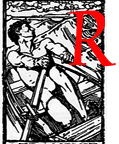[Part V of "Rochester vs. St. John Rivers: or why Jane Eyre preferred a cynical sinner to a religious zealot." All page and chapter references are to the Penguin Classic edition of the novel which contains an introduction and notes by Michael Mason.]
 ochester is Saul of Tarsus, a converted sinner and persecutor of Christians, who on the road to Damascus, is knocked to the ground, rises and becomes the greatest Christian missionary. Saul is blinded for two days and on the third day his sight is restored and he become a Christian. Rochester asks forgiveness of the Maker in the presence of Jane [III.497]. St. John Rivers is Saint John the Divine, the zealous writer of the Book of Revelations, the final and apocalyptic book of the Bible. The final reading before Evening prayers, the last ever attended by Jane under the same roof as St. John Rivers is from the Book of Revelations, Ch.XXI: It is the showing of the New Jerusalem, and so powerful is St. John Rivers reading of it, that Jane almost succumbs to his request of marriage [III.497]. She did not however like him. Her dislike is of his zealous Calvinistic principals of salvation and predestination, all contrary to Wesley's doctrine of theology, the theology of the Brontë household. With a delightful turn of irony, St. John Rivers wants Jane to support his missionary work amongst the "heathens who says its prayers to Brahma and kneels before Juggernaut", the very people who Brocklehurst links to Jane. [I.78]. The final words of the novel are of a letter written to Jane by St. John Rivers. They are the last words to be found in the Bible: the final verses of the Book of Revelation of St. John the Divine.
ochester is Saul of Tarsus, a converted sinner and persecutor of Christians, who on the road to Damascus, is knocked to the ground, rises and becomes the greatest Christian missionary. Saul is blinded for two days and on the third day his sight is restored and he become a Christian. Rochester asks forgiveness of the Maker in the presence of Jane [III.497]. St. John Rivers is Saint John the Divine, the zealous writer of the Book of Revelations, the final and apocalyptic book of the Bible. The final reading before Evening prayers, the last ever attended by Jane under the same roof as St. John Rivers is from the Book of Revelations, Ch.XXI: It is the showing of the New Jerusalem, and so powerful is St. John Rivers reading of it, that Jane almost succumbs to his request of marriage [III.497]. She did not however like him. Her dislike is of his zealous Calvinistic principals of salvation and predestination, all contrary to Wesley's doctrine of theology, the theology of the Brontë household. With a delightful turn of irony, St. John Rivers wants Jane to support his missionary work amongst the "heathens who says its prayers to Brahma and kneels before Juggernaut", the very people who Brocklehurst links to Jane. [I.78]. The final words of the novel are of a letter written to Jane by St. John Rivers. They are the last words to be found in the Bible: the final verses of the Book of Revelation of St. John the Divine.
The characters described by Jane Eyre and two of the locations of the novel — Lowood and the hamlet of Whitcross — are closely connected to a section of the Prayer Book known as the Book of Homilies, a set of notes of advice to be read to the congregation at "convenient times" throughout the year. Amongst these various ordinances is the appropriate apparel and appearance of "modesty". Jane clearly expresses her distrust of ostentation. The beauty of Georgina Reed, Blanche Ingram, Rosamund Oliver and Richard Mason are all described, but a codicil is always added as to apparent shortcomings of character; see II.247; II.195-196; III.414, and II.215 for a description of these characters. The Lowood Institute is described as "Assuredly pleasant enough: but whether healthy or not is another matter. It was in fact a cradle of fog and fog bound pestilence" [IIIp.393-394]. When Jane enters Whitcross, is a "still, hot, perfect day" and the hamlet is described in pleasant terms, but the villagers prove to have hearts as hard as flint [I.89]. The two people who Jane cares for most, Miss Temple at Lowood and Rochester, are described in far different terms than the Blanch Ingram's and Rosamund Olivers of the world. Miss Temple is described as having "refined features" [I.57]. Rochester has a face "more remarkable for character than beauty...his grim mouth, chin and jaw - yes all three were very grim, and no mistake" [III.365]. Rochester asks Jane, "do you think me handsome?" The instant answer is "No Sir" [I.149]. The man that Jane rejected, St. John Rivers, looked like a Greek God, but was without love. Passion he had only for his missionary work, not for Jane [III.386].
Other Portions of This Essay
- Introduction
- The Book of Common Prayer and Jane Eyre
- Specific dates: the link between Jane Eyre, the Book of Common Prayer, and the Bible
- Indicated Dates in Jane Eyre: the Link between the Novel, the Book of Common Prayer, and the Bible
- Conclusion: Why did Jane Eyre choose Saul of Tarsus rather than St. John the Divine?
References
Charlotte Brontë, Jane Eyre, Penguin, 1996.
The actual full title of the novel's manuscript was Jane Eyre: An Autobiography, edited by Currer Bell. The gender of the author was deliberately left ambivalent. The reason may become apparent during the reading of this article.
Last modified 19 January 1999